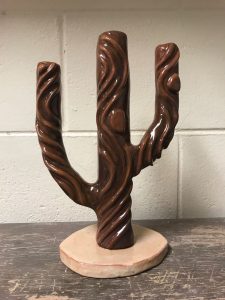
Red Earthenware Clay
Low Fire Glaze and Textured Glaze

Red Earthenware Clay
Low Fire Glazes

1.5 x 4 in.
Red Earthenware Clay
Low Fire Glaze

Red Earthenware Clay
Low fire glazes

Red Earthenware Clay
Textured Glaze
The Tree Cactus : Up Close Project
For this project, I chose to use two different plants to tie into one… the cactus and the tree. The finished project, ‘up close’ it looks to be a branch and when you zoom out you can see its a cactus. Artist Reflect: This was my 2nd to last project. Analyzing my work I have seen my progress, from the piece becoming smooth, to the layering and blending of the glazing. I have learned smoothing and glazing techniques. For smoothing, I would not only use my hands but also the wooden tools provided to get into small curves and crevices. For glazing, I learned how to layer the glazes properly so that they would blend well. Artist Create: As you may see in the picture, the “veins” of the tree are actually projecting off of the vessel itself. I used a coil technique to bring the “branch” idea more alive. Smoothing it was a challenge and took time but it definitely payed off.
_____
Matthew 7:8 Cylinder
This was my second slab project. After running my slab through the slab roller, I used a fettling knife get the correct size and square shape needed for this project. After the clay was wrapped correctly around the cardboard cylinder I used the serrated-edge scraper and smooth-edge scraper to make this piece very smooth so the sgraffito would been easily visible. I used under-glaze instead of a regular low fire glaze so that I could sgraffito onto the vessel. After the sgraffito was finished and it came out of the kiln the first time, I used a clear glaze to make this piece come out shiny, very appealing.
_____
Sea Bowl
This was my 3nd coil bowl. I was having issues making the bowl round and smooth. Instead of starting over I decided to work with the piece and give it a curvy “wave” lip. I used two different shades of blue to give the bowl an ombre effect to show some of the different colors of the ocean.
_____
Fade Ring Bowl
This was my 2nd coil bowl. You can actually see the “ridges” in the bowl where the coils were joined. At first this is not how I wanted it to appear though it ended up having a nice texture and look. I used two different greens for a fade effect.
_____
Lantern/Oil Burner
This is my final project, the second attempt (the first idea actually being the 2nd attempt.. being the successful project). Originally I had wanted to carve an elephant into the cylinder, but had decided it would end up being a thicker carve which would pull lots of light and heat out. Therefor, I decided to carve a thinner safari animal -the giraffe. Being excited and not thinking ahead I did not realize after carving out the giraffe around its tall legs, how thin the remaining clay would be in between the carvings. One of the problems I ran into was making sure those areas would dry without cracking or falling off. Now, the other problem being the oil tray. In the beginning I was very satisfied with my oil tray but decided to trim it when it was leather dry and I actually ended up poking through to the other side. I proceed to make another one which the walls ended up being too thin but I decided to try it anyhow. Hmmm. All was fine UNTIL it was bone-dry and I decided to take it outback to take a lovely picture. Only until after taking the picture did I realize one of the thin areas in between the carvings had popped off. I came back inside disappointed with the results and set my piece down, that is when the oil tray decided to crumble…. yippe. It was clear I needed to re-start. For the second attempt, I went with the first idea, the elephant. After all it is my favorite animal. The results are seen above. I am overall satisfied… though the elephant is a bit round, I think it shall be just fine with the amount of heat and light that will come out.
NOTE: NEVER TRUST THIN WALLS.

















